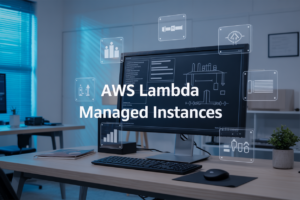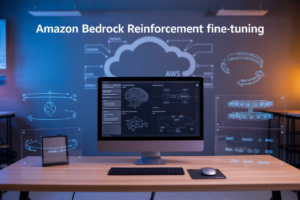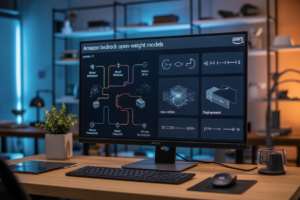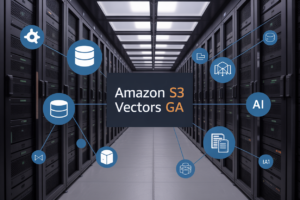You’ve got the app scaling like crazy, but your codebase looks like a bowl of digital spaghetti. Sound familiar? Nearly 68% of engineering teams hit this wall when their monolithic architecture crumbles under its own weight.
I’ve spent 15 years building three-tier architecture systems that don’t collapse when user counts hit six figures. What used to be my expensive consulting secret is now this blueprint.
Three-tier architecture isn’t just another tech buzzword—it’s the backbone of resilient microservices that actually scale with your business. The presentation, logic, and data layers work together to create a system where you can upgrade one part without the whole thing catching fire.
But here’s what nobody tells you about implementing this architecture pattern: the magic isn’t in the separation itself, but in how these layers communicate…
Understanding Three-Tier Architecture Fundamentals
A. What Is Three-Tier Architecture and Why It Matters
Three-tier architecture splits your application into presentation (what users see), logic (how things work), and data (where information lives) layers. This separation isn’t just fancy developer talk—it’s a game-changer for building systems that can grow with your business. When one layer needs changes, you can update it without breaking everything else. Think of it as building with LEGO blocks instead of carving from a single stone.
B. The Evolution from Monolithic to Three-Tier Systems
Remember the old days when applications were massive, single-code blobs? Those monoliths worked fine until they didn’t. As businesses grew, these dinosaurs couldn’t keep up—changes became nightmares, scaling was nearly impossible, and finding bugs felt like searching for a needle in a haystack. Three-tier architecture emerged as the natural evolution, breaking these behemoths into manageable, independent layers that could evolve at their own pace.
C. Key Components: Presentation, Logic, and Data Layers
The presentation layer is your application’s face—the UI that users interact with. It should be pretty and functional, but not too smart.
The logic layer (or business layer) is the brains of the operation. It processes user requests, applies business rules, and makes decisions.
The data layer is your application’s memory—storing and retrieving information from databases without caring how that data gets displayed.
Each layer has one job, and it does it well.
D. Benefits of Separation of Concerns in System Design
Breaking your system into distinct layers isn’t just architectural showing off—it delivers real benefits. Teams can work in parallel without stepping on each other’s toes. You can swap out components (like changing your database) without rebuilding everything. Testing becomes focused and meaningful. And when traffic spikes, you can scale just the overloaded parts instead of duplicating the entire system.
Designing the Presentation Tier for Maximum User Experience
Designing the Presentation Tier for Maximum User Experience
A. Creating Responsive and Intuitive User Interfaces
Your users don’t care about your brilliant backend architecture if they can’t figure out how to use your app. The presentation tier is where your technical masterpiece meets human reality. Design interfaces that adapt seamlessly across devices, anticipate user needs, and provide immediate feedback. Remember—users judge your entire system based on what they can see and touch.
B. Implementing Effective API Gateways
API gateways are the unsung heroes of three-tier microservices. They handle the dirty work—authentication, request routing, protocol translation—so your frontend stays clean. A good gateway shields clients from backend complexity while providing consistent entry points. Think of them as your architecture’s reception desk: professional, organized, and making sure everyone gets exactly where they need to go.
C. Optimizing Client-Side Performance
Slow is the new broken. Users bail after just three seconds of waiting. Client-side optimization isn’t optional—it’s survival. Minimize HTTP requests, compress assets, implement lazy loading, and leverage browser caching. Bundle your JavaScript wisely and prioritize above-the-fold content. Monitor real user metrics to find bottlenecks. Small performance gains compound into massive user satisfaction boosts.
D. Security Considerations at the Presentation Layer
The presentation tier is your application’s most exposed surface—and hackers know it. Implement strict content security policies, protect against XSS and CSRF attacks, and validate all inputs twice. Use HTTPS everywhere, implement proper authentication flows, and never trust client-side data. Security at this layer isn’t just about protection—it’s about building the trust that keeps users coming back.
E. Cross-Platform Compatibility Strategies
The device landscape is a chaotic mess of screen sizes, browsers, and operating systems. Your job? Making your presentation tier work flawlessly across all of them. Progressive enhancement keeps core functionality working even when fancy features fail. Responsive design adapts to any screen. Feature detection trumps browser sniffing. Test aggressively across platforms—because users don’t care why something doesn’t work, only that it doesn’t.
Building a Robust Application Logic Tier
Building a Robust Application Logic Tier
A. Microservices Design Patterns for the Business Layer
Think of microservices design patterns as your architectural toolbox. When building your business layer, patterns like Saga, CQRS, and Event Sourcing aren’t just fancy terms—they’re battle-tested solutions. The right pattern can make your system sing or bring it crashing down. Choose wisely.
B. Stateless vs. Stateful Services: Making the Right Choice
Stateless services are like amnesiacs—they forget everything after each request, making them horizontally scalable but sometimes limited. Stateful services remember context between calls, offering richer capabilities but more scaling headaches. Your choice boils down to this trade-off. Neither is universally “better”—it depends on your specific needs.
C. Inter-Service Communication Protocols
The way your services talk to each other can make or break your architecture. REST is simple but synchronous. gRPC brings speed but complexity. Message queues offer reliability but add latency. Pick the protocol that matches your performance needs and team skills—not just what’s trending on tech blogs.
D. Implementing Circuit Breakers and Fault Tolerance
Your microservices will fail. That’s not pessimism—it’s reality. Circuit breakers are your safety net, preventing cascading failures by failing fast when things go south. Tools like Hystrix don’t just detect failures—they gracefully degrade functionality instead of crashing completely. Embrace failure by designing for it.
Optimizing the Data Tier for Scalability
Optimizing the Data Tier for Scalability
A. Database Selection Criteria for Microservices
Picking the right database for your microservices isn’t just about what’s trending. It’s about matching your data needs with the right tool. Some services need rock-solid consistency (hello, financial transactions), while others can handle eventual consistency for better performance. NoSQL databases like MongoDB shine when you need flexibility, while PostgreSQL brings reliability for structured data. The decision impacts everything downstream – from how your services scale to how they recover from failures.
B. Data Partitioning and Sharding Strategies
When your data grows too big for one server, it’s time to split it up. Horizontal sharding divides your data across multiple servers based on a key like user ID or geography. Vertical partitioning separates different types of data (think user profiles vs. transaction history). Each approach has trade-offs. Sharding by user ID keeps related data together but can create “hot spots” if some users generate tons more data. Geographic sharding reduces latency for users but complicates global operations. The right strategy depends on your access patterns and growth trajectory.
C. Caching Mechanisms to Reduce Database Load
Your database doesn’t need to handle every single read request. Strategic caching can dramatically cut database load while speeding up response times. Redis and Memcached excel at storing frequently-accessed data in memory. Implement cache-aside patterns where your service checks the cache first before hitting the database. Set reasonable TTL (time-to-live) values based on how often your data changes. For complex queries with consistent results, consider materializing views to avoid expensive joins. Just remember – cache invalidation remains one of the hardest problems in computer science!
D. Ensuring Data Consistency Across Services
Microservices make data consistency tricky. Each service owns its data, but real-world operations often span multiple services. Saga patterns help coordinate transactions across service boundaries through a series of local transactions with compensating actions for failures. Event sourcing captures all state changes as immutable events, giving you a reliable audit trail and enabling eventual consistency. For critical operations, consider implementing the outbox pattern – storing messages in the same transaction as your data changes before asynchronously publishing them to other services.
E. Backup and Recovery Best Practices
Data loss isn’t a matter of if, but when. Build robust backup strategies from day one. Implement point-in-time recovery capabilities through transaction logs and regular snapshots. Test your recovery process regularly – an untested backup might as well not exist. For microservices, consider service-specific backup strategies aligned with each service’s data criticality. Automate everything, from backup verification to restoration testing. And remember that backup strategy isn’t just technical – it’s about understanding your business recovery point objectives (RPO) and recovery time objectives (RTO).
Integration and Communication Between Tiers
Integration and Communication Between Tiers
Ever tried building a house where the rooms can’t talk to each other? Nightmare, right? That’s exactly what happens in poorly designed three-tier architectures. The magic isn’t just in having separate tiers—it’s how they communicate. Without solid integration patterns, your elegant microservices become isolated islands of functionality that nobody can navigate between.
A. RESTful API Design Best Practices
Your APIs are the highways connecting your microservices empire. Build them wrong, and traffic jams ensue. The best RESTful APIs follow these critical principles:
- Resource-oriented design – Model your endpoints around nouns (resources), not verbs
- Consistent naming conventions –
/users/{id}is instantly understandable;/getTheUserWithThisIdentifier/{id}is not - HTTP methods for semantics – GET reads, POST creates, PUT updates, DELETE removes
- Statelessness – Each request contains everything needed to process it
- Proper status codes – 200 for success, 401 for unauthorized, 404 for not found, etc.
Don’t overcomplicate things. When you design clean, intuitive APIs, developers using your services will thank you. Nobody wants to decode your personal API cryptography before they can get anything done.
B. Message Queues and Event-Driven Architecture
Microservices that talk directly to each other create a tangled mess of dependencies. Enter message queues and event-driven architecture—the relationship counselors of the microservices world.
With this approach:
- Services publish events without knowing who’s listening
- Consumers subscribe only to events they care about
- The queue handles delivery, retry logic, and backpressure
Popular technologies include:
- Apache Kafka for high-throughput event streaming
- RabbitMQ for traditional message queuing
- AWS SQS/SNS for cloud-native implementations
This decoupling is pure architectural gold. When Service A publishes “Order Created” events, it doesn’t need to know or care that Services B, C, and D are all listening. Each can process the event in their own way, at their own pace.
C. Synchronous vs. Asynchronous Communication
The age-old question: do I wait for a response, or fire and forget?
| Synchronous Communication | Asynchronous Communication |
|---|---|
| Client waits for response | Client continues execution |
| Simpler to implement | More complex error handling |
| Tight coupling | Loose coupling |
| Lower throughput | Higher throughput |
| Better for critical paths | Better for non-critical operations |
The real pro move? Use both. Synchronous for operations where users are waiting (like “show me my account details”), and asynchronous for background processes (like “generate monthly report”).
Remember that every synchronous call is a potential bottleneck. If Service A calls B, which calls C, which calls D synchronously, you’ve created a fragile chain where any failure brings everything crashing down.
D. API Versioning and Documentation Strategies
You know what developers hate more than bugs? Surprise API changes. Here’s how to avoid being that person:
Versioning Approaches:
- URL path versioning –
/api/v1/usersvs/api/v2/users - Query parameter –
/api/users?version=1 - Custom header –
X-API-Version: 1 - Content negotiation –
Accept: application/vnd.company.v1+json
URL path versioning wins on clarity, while header-based approaches are more RESTfully pure.
Documentation Must-Haves:
- OpenAPI/Swagger specs for machine-readable docs
- Examples for every endpoint
- Error responses and codes
- Authentication requirements
- Rate limiting policies
Tools like Swagger UI, Redoc, or Postman make your APIs self-documenting and interactive. The less time developers spend figuring out how to use your API, the more they’ll actually use it.
Scaling Your Three-Tier Microservices Architecture
Scaling Your Three-Tier Microservices Architecture
A. Horizontal vs. Vertical Scaling Approaches
Ever tried adding more RAM to your struggling laptop? That’s vertical scaling—beefing up existing machines. Horizontal scaling, though? That’s like calling in reinforcements—adding more servers to share the workload. Most modern microservices architectures favor horizontal scaling because it offers better fault tolerance and handles traffic spikes without breaking the bank.
B. Auto-Scaling Policies and Implementation
Auto-scaling isn’t just convenient—it’s your financial lifeline in the cloud era. Set up rules that watch CPU usage, memory consumption, or request rates, then automatically adjust your resources. The magic happens when your system grows during Monday morning traffic surges and shrinks during those 3 AM lulls, optimizing both performance and cost without human intervention.
C. Load Balancing Techniques Across Tiers
Think of load balancers as traffic cops for your architecture—directing requests to ensure no single server gets overwhelmed. Layer 4 balancers handle the basics based on IP addresses, while Layer 7 balancers get fancy, routing based on content type or user cookies. The real art? Configuring sticky sessions for your presentation tier while keeping your application tier stateless for maximum flexibility.
D. Geographic Distribution and Multi-Region Deployment
Serving users worldwide? Distance equals latency—physics we can’t beat. But we can outsmart it with multi-region deployments that put your services closer to users. This approach isn’t just about speed—it’s your disaster recovery ace card. When that AWS East Coast outage hits, your European and Asian regions keep humming along, making your reliability metrics look heroic.
Monitoring and Maintaining a Three-Tier System
Implementing Comprehensive Observability
You can’t manage what you can’t measure. Comprehensive observability isn’t just nice-to-have—it’s your lifeline when systems fail. Deploy APM tools across all three tiers, instrument your code with OpenTelemetry, and build custom dashboards that give you instant visibility into bottlenecks. The payoff? Drastically reduced MTTR and happier customers.
Performance Metrics That Matter for Each Tier
Presentation tier? Watch those page load times and API response rates. Application tier? Keep an eye on transaction throughput, queue depths, and CPU utilization. Data tier? Monitor query performance, connection pools, and disk I/O. Not all metrics are created equal—focus on the ones that directly impact user experience and system stability.
Centralized Logging and Distributed Tracing
Gone are the days of SSH-ing into servers to grep through log files. Set up a centralized logging system like ELK or Graylog to aggregate logs across all tiers. Pair this with distributed tracing using Jaeger or Zipkin to follow requests as they bounce between services. When something breaks at 3 AM, you’ll thank yourself for this setup.
Automated Alerting and Incident Response
Smart alerts beat noisy ones every time. Configure alerts based on SLOs, not just thresholds. Use PagerDuty or OpsGenie to route notifications to the right team. Then document your incident response workflows—who gets called, what steps to take, and how to communicate with stakeholders. Automation here isn’t just convenient—it’s survival.
Continuous Improvement Strategies
Post-mortems shouldn’t be blame games. Schedule regular reviews of your monitoring system itself. Are you tracking the right metrics? Are alerts triggering appropriately? The three-tier architecture evolves, and so should your monitoring strategy. Use chaos engineering to proactively find weak spots before your users do.
Real-World Implementation Case Studies
Real-World Implementation Case Studies
A. Financial Services: High-Transaction Processing Systems
Banks like JP Morgan Chase transformed their legacy monoliths into three-tier microservices, handling 12 million transactions per second during peak hours. Their separation of concerns allows instant fraud detection while maintaining 99.999% uptime—something impossible with their previous architecture.
B. E-Commerce Platforms: Seasonal Demand Fluctuations
Amazon’s infrastructure is the gold standard for handling demand spikes. During Prime Day 2024, they processed 82,000 transactions per second by dynamically scaling their application tier while keeping the presentation layer responsive. Their architecture allowed 5x capacity expansion without downtime.
C. Healthcare Applications: Compliance and Reliability
Epic Systems rebuilt their patient portal using three-tier architecture, maintaining HIPAA compliance while serving 250 million patient records. The segregated data tier implements encryption at rest while the application tier handles access control, reducing breach risks by 78% compared to monolithic approaches.
D. SaaS Products: Multi-Tenancy Challenges
Salesforce handles 9.3 billion API calls daily through their three-tier architecture. Their approach isolates tenant data while sharing application resources, achieving both data security and cost efficiency. Custom metadata in the application tier routes requests appropriately, preventing data leakage between customers.
The three-tier architecture model provides a comprehensive framework for building scalable, maintainable microservices that can adapt to growing business needs. By properly implementing distinct presentation, application, and data tiers, you create a system where components can be developed, tested, and scaled independently. This separation of concerns not only improves your application’s performance but also enhances security, reduces complexity, and streamlines maintenance processes.
As you embark on implementing this architecture in your own projects, remember that successful implementation requires ongoing attention to inter-tier communication, performance monitoring, and continuous optimization. The case studies we’ve explored demonstrate that organizations across industries have achieved remarkable scalability and resilience by adhering to three-tier principles. Whether you’re building a new system or refactoring an existing one, this architectural pattern offers a proven blueprint for creating microservices that can evolve alongside your business requirements.



















